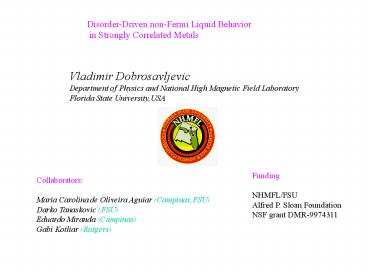DisorderDriven nonFermi Liquid Behavior - PowerPoint PPT Presentation
1 / 17
Title:
DisorderDriven nonFermi Liquid Behavior
Description:
Phenomenological Kondo-Disorder Model (DKM) Broad distribution of ... Phenomenology IDENTICAL. as in the Kondo disorder model (only thermodynamics explored) ... – PowerPoint PPT presentation
Number of Views:83
Avg rating:3.0/5.0
Title: DisorderDriven nonFermi Liquid Behavior
1
Disorder-Driven non-Fermi Liquid Behavior in
Strongly Correlated Metals
Vladimir Dobrosavljevic Department of Physics and
National High Magnetic Field Laboratory Florida
State University,USA
Funding NHMFL/FSU Alfred P. Sloan Foundation NSF
grant DMR-9974311
Collaborators Maria Carolina de Oliveira Aguiar
(Campinas,FSU) Darko Tanaskovic (FSU) Eduardo
Miranda (Campinas) Gabi Kotliar (Rutgers)
2
Contents
3
Disorder-driven NFL behavior doped semiconductors
- NFL two-fluid thermodynamics
- Conventional FL transport
- (FL for disordered systems)
4
Disorder-driven NFL behavior Kondo alloys
Effects of disorder
T a-1
NOTE a 1 (marginal!!)
5
Phenomenological Kondo-Disorder Model (DKM)
Broad distribution of Kondo temperatures, Due to
random environment (random J-s) P(TK) fitted for
susceptibility
6
Microscopic Basis for DKM Dynamical Mean-Field
Theory (DMFT)
- Anderson lattice model, random Kondo couplings
- JK V2/Ef distribution from fitted P(TK)
Integate out all sites but one
f-sites
c-sites
Environment of Kondo spin hybridization function
determined self-consistently
DISORDER
7
Successes of the DMFT-DMK Model
- For UCu5-xPdx explained with no additional
fitting parameters - specific heat, dynamic neutron scattering,
optical conductivity, - resistivity, magnetoresistance,
8
Magnetic Griffiths phase (MGP) scenario (Castro-Ne
to Jones, 1999, 2001)
- Idea proximity to a magnetically ordered
phasedisorder - Clusters (droplets) form even before global
ordering - Numerical evidence of this in insulating random
magnets - (Huse, Bhatt, et al.)
- Metallic host quantum tunneling of clusters
(cluster Kondo effect) - Distribution of clusters sizes
distribution of tunneling rates TK
- Phenomenology IDENTICAL
- as in the Kondo disorder model
- (only thermodynamics explored)
- P(TK) (TK)a-1 c(T) (T)a-1
- Non-universal exponent a
Rare, dilute magnetically ordered cluster
9
Why is the magnetic Griffiths phase is an
unlikely explanation?
- How much entropy is due to NFL? A lot !!!!
- Estimate from DKM fit of P(TK)
- (relevant for both models)
- There are 3-10 free two-level fluctuators
- (Kondo spins or droplets) per unit cell!!!
- (temperature range 10-50K)
- Average distance is 2-3 lattice spacings
- Clusters if existing CANNOT be large
- (as assumed in MGP scenario)
- Dissipation due to fermionic bath
- (as in Caldeira-Leggett problem)
- Millis, More, Schmalian (PRL 2001, PRB 2002)
- show that larger clusters are overdamped
- i.e. there is no tunneling!!!!
- (key assumption of MGP scenario)
cluster Kondo effect favors tunneling
10
Disorder-driven NFL - open questions
11
Localization-induced electronic Griffiths
phase (Miranda Dobrosavljevic, PRL 2001)
The physical picture
12
Localization interaction statDMFT approach
- Localization fluctuations of the cavity
- which is now site-dependent
Greens function of conduction electrons with
site j removed
Sum over z sites
- Quasiparticle Hamiltonian for conduction
electrons (diagonalize numerically)
- Scattering potential from Kondo centers
- Efficient numerical implementation on Bethe
lattices (recursion)
13
- Experiments distribution of
- distances (Kondo couplings JK)
- Compare results of
- Single impurity model
- DMFT-CPA
- StatDMFT (includes localization)
- Feedback effects of localization
- UNIVERSAL form of P(TK)
- Still too few low TK s, no NFL
14
(for Anderson lattice and Hubbard models)
15
(No Transcript)
16
(No Transcript)
17
(No Transcript)































